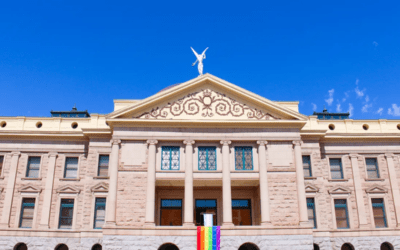
The top 1% of Arizona earners make 21 times more income than the bottom 99%.
The economy is routinely a top issue when Arizonans head to the polls—and 2020 is no exception. That might be unsurprising, as the coronavirus pandemic has brought on a recession and historic unemployment. However, America’s wealthiest people have actually gotten richer during this time—a trend that has been happening for the past five decades.
A recent study put this fact into stark perspective. Middle class workers made an average of $42,000 in the United States in 1975. In 2018—halfway through President Trump’s term—that number had increased only $5,000 to $50,000 per year. If that income had grown at the same rate as the economy, middle-class Americans would be making almost double what they are now: $92,000. Salaries would also be double for the lowest-income Americans, going from $33,000 to $61,000.
In other words, America’s middle class is missing out on $42,000 per year.
Despite the Trump administration’s insistence that they have been good for the economy, the growth in salaries that should have happened for the working class have not.
The same study found that the top 1% of American earners made an average of $289,000 in 1975. In 2018, that number had risen to $1.3 million—a gain that far outpaces the economic increase seen during the same time. If the richest Americans had their income tied to that measure, it would be $630,000, not $1.3 million.
Even before the pandemic, the American middle class was—by and large—shrinking. The United States has higher income inequality than nations like the United Kingdom, Japan, Germany, and France. And that growing inequality has only extended the decline of the middle class.
RELATED: Arizonans Making Less Than $25,000 per Year Hardest Hit by Pandemic
In 2016, 52% of the population were considered middle class, up one point from the number of Americans in the middle class in 2011, and still making it the largest economic class in the country. However, as of 2018, the middle class was earning less than half of the income in the nation—despite making up more than half of the economy.
According to the Economic Policy Institute, Arizona ranks 18th in the country for income inequality. The top 1% of earners make 21 times more income than the bottom 99%. The average annual income of the 1% is over $880,000, while it’s only $42,000 for the rest of the state’s population.
President Donald Trump said his 2017 tax plan would focus on “helping the folks who work in the mailrooms and the machine shops of America.” But a study from the nonpartisan Tax Policy Center found that a large majority of the tax savings (60%) went to people making the top 20% of incomes in America.
The problems caused by those tax cuts have only been exacerbated by the pandemic. Trump’s refusal to take the coronavirus seriously—by delaying testing, encouraging states to reopen quickly, and not enforcing a national mask mandate—continues to crush middle class Americans who work jobs that can’t be done from home or without child care.
And the pandemic has proven to most negatively affect Arizonans with lower incomes. A Morrison Institute poll found that 35% of Arizonans making less than $25,000 per year lost their jobs as a direct result of the pandemic, while 14% were furloughed. Among those making more than $150,000 per year, only 6% lost their jobs or were furloughed.
Trump’s second-term agenda includes a vague bullet point that promises to “cut taxes.” But he doesn’t say how he would do that, and who would be helped by those further cuts.
RELATED: Coronavirus Is Exposing Why the Affordable Housing Crisis Is Also a Healthcare Crisis
That’s a stark contrast to Democratic presidential candidate Joe Biden’s plans for providing concrete assistance to working class Americans. Biden’s plan centers on no tax increases for 98% of working Americans. Instead, he would limit deductions, breaks, and loopholes for the 2% of Americans making more than $400,000 per year to help offset the toll the pandemic has taken on working-class Americans.
But Biden’s plan is far more robust than the bullet-point Trump has offered. Here’s what else to expect in Biden’s tax plans:
- Increase the tax rate on the highest income earners (about $510,000 or more) from 37% to nearly 40%. That is the rate this group was taxed at before Trump tax bill.
- Cap some deductions for the wealthiest Americans, meaning potential tax increases for some individuals or families who make $400,000 or more.
- Make the wealthiest Americans pay their fair share in Social Security taxes. Right now, any income above $137,000 isn’t taxed for Social Security. Biden’s plan would restart the tax on any income above $400,001. It would also close that gap over time, so everyone is paying a portion of their full salary into Social Security, regardless of how much money they make.
- Right now, earnings from investments are taxed at only about half as much as regular income, disproportionately benefiting wealthy Americans (only 22% of Americans making less than $40,000 per year own stock). Biden would tax investments like real estate and stock over $1 million at the same rate as regular income.
- Raise taxes on corporations that benefit from the labor of the American working classes and consumer markets.
- Prevent companies like Amazon from avoiding tax payments altogether by establishing a minimum 15% tax on corporate profits.
Support Our Cause
Thank you for taking the time to read our work. Before you go, we hope you'll consider supporting our values-driven journalism, which has always strived to make clear what's really at stake for Arizonans and our future.
Since day one, our goal here at The Copper Courier has always been to empower people across the state with fact-based news and information. We believe that when people are armed with knowledge about what's happening in their local, state, and federal governments—including who is working on their behalf and who is actively trying to block efforts aimed at improving the daily lives of Arizona families—they will be inspired to become civically engaged.


BREAKING: AG Kris Mayes sues rental corporations for conspiratorial price-fixing
It looks like, legally speaking, rent really may be “too damn high.” Arizona Attorney General Kris Mayes announced Wednesday a lawsuit against nine...

Op-ed: Trump’s journey from hosting The Apprentice to being the biggest loser
Leading up to the 2016 election, Donald Trump crafted an image of himself as a successful businessman and a winner. But in reality, Trump has a long...

Kari Lake’s plan for the US Senate: ‘The end of democracy’
The world’s most far-right political leaders flocked to National Harbor, Maryland, last week for a conservative conference where attendants idolized...

Flight attendants picket at more than 30 airports in ‘unprecedented’ show of solidarity
Hundreds of flight attendants picketed at Phoenix Sky Harbor Airport last week, calling attention to stagnant wages with low purchasing power, poor...





